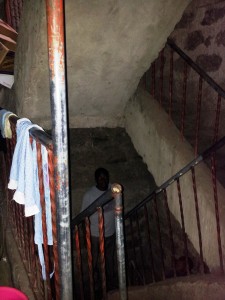A couple of weeks ago the news came out that Kenya has seen its economy grow 25% after statistical revision. Officially, Kenya is now a “middle-income country.” A few months ago, a similar type of revision brought Nigeria’s economy to the top of African countries in terms of the size of the economy, surpassing South Africa for the first time. A growing middle class population is an important driver of this growth. But what does that middle class look like? Let’s look at Kenya. The recently revised Kenyan figures indicate that GNI per capita is $1,160. The World Bank’s “middle income” threshold is $1,036. The latest official (i.e. the World Bank’s) income-distribution indicators in relation to Kenya date back to 2005; just a couple of figures:
- 45.9% of the population were at the national poverty line;
- the income share held by the top 10% was 38%.
This is out-of-date, official information — with all of the issues that excluding the informal economy implies. Now, a part of the reality I have observed: a taxi driver I became familiar with makes KES15,000/month (about US$178 or €132), and pays KES3,500 (close to 25% of his income) to rent a room where he lives with his wife and two children. They don’t have a kitchen or a bathroom: these are facilities shared with others in the same building lot. His income is pretty much the average salary of a driver, according to the Kenya Economic Survey 2014.

Is he middle class? I don’t know at which socio-economic group he would belong to officially: his annual income (US$2,136) makes him above the World Bank’s threshold but this is the only income to a household of four (US$534/capita). What I know is that the room he rents is in the building that you see in the picture: they are not the poorest of the poor by far, and this is how most Kenyans live (he told me). I know also that the Fanta and cookies they offered me were well beyond their means – still, they didn’t hesitate to treat the visitor as they did: a clear sign of generosity that made me ashamed.
Just food for thought… so – any thoughts?


In Kenya (and many other emerging economies) people face a dilemma. The jobs are in the biggest cities but housing is very expensive there. I had a chat with someone from a large European consulting firm recently. They pay the same in Lagos as they do in Europe. So my first reaction was that this is pretty good but he explained that it is actually more expensive to live in Lagos then in Berlin.
This is a common issue. For example the nice parts of Mumbai are more expensive to live in than Manhattan.
Hi Christian, this is very important so as to have a better picture of what it’s like living in this type of countries. Thanks for bringing it up!
It’s very right what Christian said. In many countries out of our western enviroment, keeping our standards means much more expensive that we can imagine. But beside this economic aspects, there is the human behavior of these people around the world who are able to deliver even what they don’t have. It can seem strange but values many times are different to those ones we are used to live.
That’s been my experience, Jose-Pedro: I’ve been overwhelmed by the generosity of African people — both the rich and the poor.